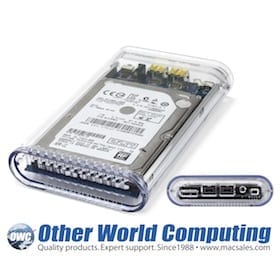 Other World Computing announced today the ‘Triple Interface’ model of its award-winning OWC Mercury On-The-Go Pro bus-powered portable storage solution now features a USB 3.0 ‘SuperSpeed’ port which is also USB 2.0 backwards compatible. Complemented by two FireWire 800/400 ports, the new USB 3.0 capability enables the Mercury On-The-Go Pro to deliver real-world, benchmark-proven data transfer speeds up to 285MB/s. All that speed is housed in a pocket-sized drive offering up to 1.0TB of storage capacity—enough space to hold up to one million JPEG photos, 500 DVD movies, 76 hours of digital video, or 350,000 MP3 songs.
Other World Computing announced today the ‘Triple Interface’ model of its award-winning OWC Mercury On-The-Go Pro bus-powered portable storage solution now features a USB 3.0 ‘SuperSpeed’ port which is also USB 2.0 backwards compatible. Complemented by two FireWire 800/400 ports, the new USB 3.0 capability enables the Mercury On-The-Go Pro to deliver real-world, benchmark-proven data transfer speeds up to 285MB/s. All that speed is housed in a pocket-sized drive offering up to 1.0TB of storage capacity—enough space to hold up to one million JPEG photos, 500 DVD movies, 76 hours of digital video, or 350,000 MP3 songs.
Pocket-Sized and Bus Powered – Ideal for the Mobile Office
Designed for the active “On-The-Go” computer user who needs the largest and fastest portable storage solution available on the market, the Mercury On-The-Go Pro is compact at 3.5″x 5.5″x 1″ in size — small enough to fit into a shirt pocket, yet big enough to offer up to 1TB of capacity. Stylishly engineered in a sleek, acrylic enclosure, the Mercury On-The-Go Pro is bus-powered, so it doesn’t require an AC adapter, which makes it ideal for presentations, multimedia, law enforcement, surveyors, and other “mobile office” uses. Additionally, notebook users with internal 5400RPM drives will find that using the Mercury On-The-Go Pro 7200RPM and SSD models as a start-up disk offers faster system boot-up and overall system performance.
Works with Macs, PCs, and Digital Devices
Featuring a variety of the latest and backward compatible FireWire and USB interfaces, the Plug-and-Play ready Mercury On-The-Go Pro can be used with current and legacy Macs and PCs for additional storage capacity, transporting large files between multiple computers and real-time A/V editing. The drive can also be used with storage capable digital cameras and camcorders with FireWire and/or USB data ports for quick, convenient backups of images and video while on the road.
Backed by the Best Support in the Industry
The best product warranty is one a consumer should never have to use, but should the need occur, OWC’s stellar reputation for support offers peace of mind ownership. All OWC Mercury On-The-Go Pro storage solutions come fully backed by free lifetime US-based 24/7 technical support and a three-year warranty which includes a 48-hour repair turnaround time with up to one year of complimentary Level 1 data recovery service.
“USB 3.0 is fast becoming the high-performance interface standard for the majority of everyday Mac and PC computer uses,” said Larry O’Connor, CEO, Other World Computing. “Adding ‘SuperSpeed’ capability to our flagship portable Mercury On-The-Go Pro will keep it on top as one of the best-selling portable drives on the market.”

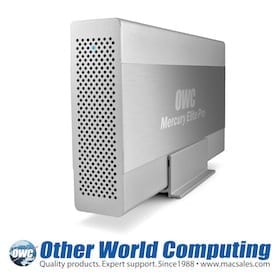
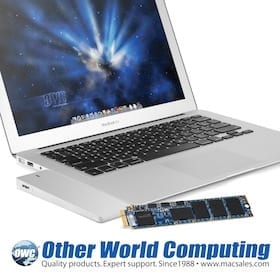
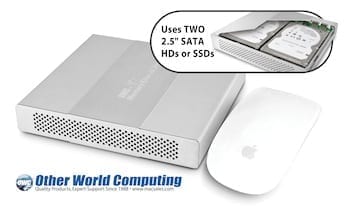

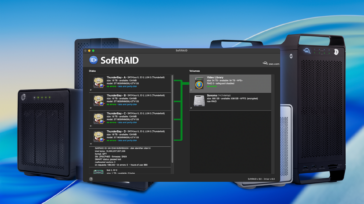
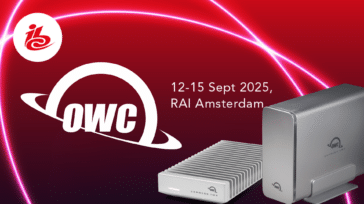



We have several Thunderbolt-equipped products that we will be launching in the upcoming months. We cannot speak as to specifics of what products are coming when. Bookmark the OWC Blog to stay up to date on the latest information as it is available.
Thanks! Looking forward…
I’m looking forward to seeing a Thunderbolt enclosure with an SSD to match the size of my Macbook Air for clone backups.
I noticed that Lacie released their Rugged Triple this week with usb 3.0 and dual fw800. Are you guys using the same chipset or sourcing the same boards as them on the “On The Go Pro”?
The board design to the On The Go Pro is proprietary, so they wouldn’t be sourcing our board, and as LaCie doesn’t mention what chipset they use in their external drives we really can’t say if they’re the same chipset.
Please bring the real McCoy: 2 x Thunderbolt for daisy chain and USB 3. Follow Apple’s lead!!! Also for 3.5-inch 4 TB and soon 5 TB models 7200 rpm. Thanks.
What’s the internal interface on this enclosure – does it support SATA III (6.0Gb/s), or does it only support SATA I/II (1.5/3.0 Gb/s)? It seems that most 2.5″ USB 3.0 enclosures support only up to SATA II, and thus are unable to take advantage of the full speed available by some of the faster SSD’s out there.
If SATA III is already supported on this enclosure, then why is the maximum speed quoted at only 285MB/s? According to your own benchmarks, OWC SSD’s should be able to reach well over 500 MB/s (ex – the Mercury Extreme Pro 6G’s read at up to 559 MB/s)! Is there really so much overhead to cause speeds to be almost halved?
Genuinely curious – any help would be greatly appreciated! =)
It is currently a SATA Revision 2.0 chipset being used – limiting speed to a theoretical maximum of 300MB/s
So will there be a SATA III version at some point in the near future? It would seem to make sense to enable as much speed as possible, especially with SSD’s as fast as they are these days!
As you point out yourself, the theoretical limit of the enclosure is only 300MB/s, which is well below the maximum transfer rates of most decent SSD’s now available, and also well below the theoretical bandwidth of USB 3.0. What would be the obstacle(s) for using a SATA III chipset? Are there technical reasons, or is it a matter of $$$?
Thanks again for your help! =)
We can’t really speak as to future releases of products.
Looks neat but I’m holding off for an OWC thunderbolt solution. I’m dying to add an ssd drive to my iMac but don’t want to tear in to it. Any word on a thunderbolt version of this?
How about a small, portable thunderbolt drive?
The problem with that is, I use the previous model for daisy chaining FW devices. Is daisy chaining over USB 3.0 even possbile (obviously not for FW devices)? I know target disk mode is not. I assume not; otherwise, why only one USB port?
With my old model, I use FW 800 at home, and USB 2.0 in the rare cases when I have to connect it to a USB-only Mac. I’m not sure what the point of two FW 800 ports are on this, anymore. One for Target disk mode, and then…? I don’t understand who this product is aimed at. I do understand that it’s the same thing as the old model, with updated an USB port, but I don’t see how that makes any sense.
I think I’ll pass and buy the Mercury Elite Pro Dual mini with two Thunderbolt ports, and one USB 3.0 port, when you sell that.
Daisy-chaning in the FireWire sense isn’t the same via USB. With USB you use hubs and can access up to 127 devices from a single port on your computer, but the devices don’t link port to port to port like FireWire does. So it does make sense that just the one port gets updated. And since USB 3.0 is backwards compatible with USB 2.0 we’ve just expanded the capability of the drive without taking anything away.
Plus, to clarify further, Jessy:
Target Disk Mode is connecting two Macs with a Firewire (not USB) cable. The one that has been rebooted while holding the T key acts as an external HD for the other Mac.
Intel Macs can boot from an external drive when it is connected to it by either a Firewire or USB cable. Using these external drive enclosures will allow connecting by USB or by Firewire. This is not called Target Disk Mode.
There are two Firewire 800 & 400 ports because daisy chaining allows another Firewire device to be plugged into the extra Firewire port of a Firewire device that has been connected to the Firewire port of a Mac.
I know what Target Disk Mode is. I’m asking what customer actually uses it, and then wants something daisy chained on top of that? Target Disk Mode is not something I get the impression people use often. When I use it, I’m not in my normal workflow or cabling setup.
Right now, my old model On-The-Go makes sense. I use FW 800 because it’s the fastest port avilable on the enclosure, and then daisy chain an audio interface. If I were to get the new model, I wouldn’t be using FireWire at all, because it’s no longer the fastest port, and I can connect directly to the audio interface. What I’ve come up with is that you’re marketing this at a FireWire user who doesn’t have USB 3.0 capability, YET. That makes enough sense.
Is there a document somewhere that explains the hub vs. daisy chain difference? I’d like to know why the USB model doesn’t act as a 2-port “hub”, with one hardwired to the drive. (That would be nice on the model with FW, too, but I don’t know if space would allow it.)